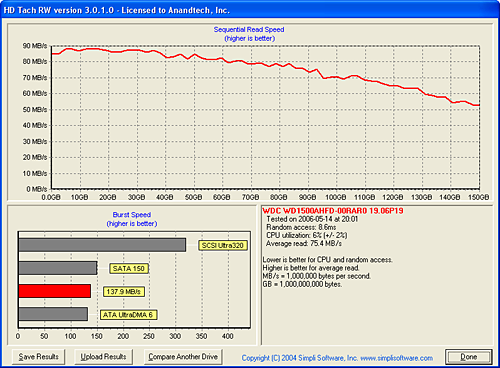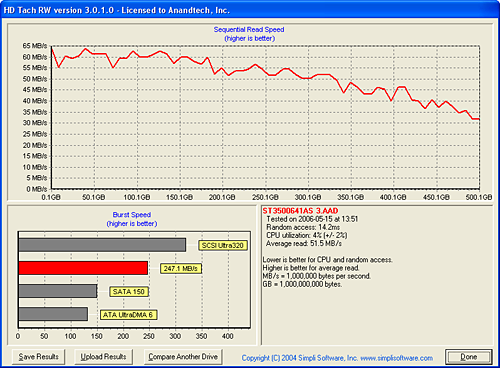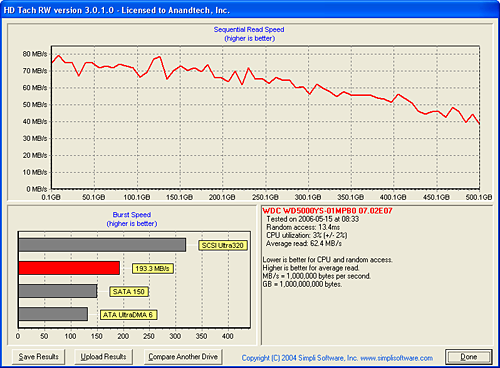Seagate Barracuda 7200.10 750GB: Size Does Matter
by Gary Key on May 18, 2006 9:00 AM EST- Posted in
- Storage
Features and HD Tach Test
| Drive Specifications | ||||
| Seagate Barracuda 7200.10 ST3750640AS |
Western Digital Raptor WD1500ADFD |
Western Digital RE2 WD5000YS |
Seagate Barracuda 7200.9 ST3500641AS |
|
| Manufacturer's Reported Capacity | 750GB | 150GB | 500GB | 500GB |
| Operating System Reported Capacity | 698.6GB | 139.7GB | 465.8GB | 465.8GB |
| Interface | SATA 300MB/s | SATA 150MB/s | SATA 300MB/s | SATA 300MB/s |
| Rotational Speed | 7200 RPM | 10000 RPM | 7200 RPM | 7200 RPM |
| Cache Size | 16 MB | 16 MB | 16 MB | 16 MB |
| Average Latency | 4.16 ms (nominal) | 2.99 ms (nominal) | 4.20 ms (nominal) | 4.16 ms (nominal) |
| Read Seek Time | 11 ms | 4.5 ms | 8.7 ms | 11 ms |
| Number of Heads | 8 | 4 | 8 | 8 |
| Number of Platters | 4 | 2 | 4 | 4 |
| Power Draw Idle / Load | 9.3W /12.6W | 9.2W / 10.0W | 8.9W / 10.8W | 7.4W / 13W |
| Command Queuing | Native Command Queuing | Native Command Queuing | Native Command Queuing | Native Command Queuing |
| Warranty | 5 Years | 5 Years | 5 Years | 5 Years |
The Seagate 7200.10 750GB drive we are reviewing today will be compared against two of the leading 500GB drives from Seagate and Western Digital along with the drive that has redefined performance in the Serial ATA market, the Western Digital WD1500 Raptor. While our Seagate 750GB drive is not in the same market sector as the Raptor, we thought it would be interesting to see how the two drives at the top of their respective classes perform against each other in our testing.
We are providing RAID 0 results for the Seagate 7200.10 for comparative results to the single drive. Seagate has recently released updated firmware for the 500GB 7200.9 that improves RAID performance; unfortunately we were unable to complete our testing with the new firmware before publication. Our RAID results for the WD1500 series will be published in our next storage article. The Western Digital 500GB drive is actually from the RE2 family and its design aspects are based upon the Raptor family. We will be having a 500GB roundup in the near future and will include the updated Hitachi Deskstar, Maxtor DiamondMax 11, Western Digital WD5000KS, and Seagate's own 7200.10 unit in our test results.
All of our drives are tested with Native Command Queuing (NCQ) enabled if the drive supports this technology. The reason for this is that a majority of users will not take the time to toggle NCQ on or off in the drivers so our test results will reflect this pattern. Native Command Queuing performance in single user applications has generally extracted a minor performance penalty when left enabled, with scores generally being 2%~4% lower in the current generation of drives. We noticed a 1% to 3% performance drop with the Seagate 7200.10 in our IPEAK benchmarks but nothing that would be noticed in actual application usage. Our recommendation at this time is to disable NCQ in single user environments to maximize the performance of the drive.
In the case of SATA 1.5Gbps/3Gbps operation we will remove the drive jumpers to enable this function if the drive supports it. Unless your core logic chipset and drivers support SATA 3Gbps operation, do not remove the drive jumper as this will generally result in a non-boot situation. The WD1500 Raptor does not support SATA 3Gbps operation and will operate at SATA 1.5Gbps. We did not notice a performance delta in the 7200rpm drives when enabling 3Gbps operation except in our synthetic benchmarks that measure and report burst speeds.
HD Tach




We find HD Tach to be useful for generating random access and average transfer rate results in a very consistent manner. Although the burst rates and CPU utilization rate numbers are somewhat interesting, they tend to be useless in actual application performance comparisons. In real world terms, CPU utilization rates in any DMA based storage system will typically be under 1% in all instances.
The Raptor has the highest average read rate of 75.4 MB/s with the Seagate 750GB drive following fairly closely with 66.9 MB/s, the Western Digital 500GB drive at 62.4 MB/s, and falling way behind at 51.5 MB/s is the Seagate 500GB drive. The 7200.10 has improved upon the 7200.9 series in this test by 29%.
The sequential read speed at the 500GB level for the 7200.10 is averaging 70 MB/s while the 7200.9 finishes at 31 MB/s. The Seagate 7200.10 and WD 500GB drives score about 40 MB/s at the end of the disk. In contrast, the WD Raptor finishes with a 52 MB/s result that is about 30% greater than the 7200 RPM drives. However, if you look at the read performance for the first 150GB on the 7200 RPM drives, all three manage higher minimum transfer rates than the Raptor.
The random access time benchmark favors the 10,000 RPM spindle speed of the Raptor, which generates a result of 8.6ms. The 7200 RPM drives results are all close together with the nod going to the WD 500GB drive at 13.4ms and the Seagate 750GB/500GB drives finish at 14.0ms and 14.2ms respectively. The average rotational latency at 10,000 RPM is 3ms while the average rotational latency at 7200 RPM is 4.17ms; what this means is that the head seek speed on the Raptor is significantly faster (~5.6ms) than the other drives (9.2-10.0ms). Although the two Seagate drives have excellent burst rates, we will soon see these results do not directly translate into class leading performance.










44 Comments
View All Comments
JakeBlade - Friday, May 26, 2006 - link
Interesting that this drive has a MADE IN SINGAPORE label instead of Seagate's usual MADE IN CHINA junk.ElFenix - Friday, May 19, 2006 - link
no reason to upgrade from my SE16, i see.i'd like to see a couple more drives in tests, such as the latest hitachi.
Gary Key - Friday, May 19, 2006 - link
The reason we did not include the Hitachi unit is we have the revised 500GB unit arriving shortly and as mentioned in the article we will have a complete 500GB roundup with the new 7200.10 also. It will take some time to build the database with the revised test suite as we also have additional application timer tests coming shortly.
The performance across most of the recently released mainstream drives is so close now that it comes down to a personal decision on warranty, reliability, thermals/acoustics, and capacity for the most part. However, drives like the Raptor and RE2 series do make things interesting for SATA on the desktop as did this drive for a PVR fanatic. ;-)
ElFenix - Friday, May 19, 2006 - link
i'd also like to see audio tests from a little bit further away. 5 mm doesn't give a realistic idea of how loud it will be sitting 3 feet away on the floor. plus, for all i know where you place the microphone is extremely important when at 5 mm.Gary Key - Friday, May 19, 2006 - link
There is no one good area to measure the acoustics as you never know where the PC will be located, what type of case, fan noise, or ambient sounds are present. I can tell you that a drive that is loud at 3mm~5mm will be loud at three feet with all things being equal. Sound tones are also very subjective, the dull thumping sound the drive has under load might be perfectly acceptable while the higher pitched clicking sound of a Maxtor will be unbearable for some people.
We place the two mics at different points on the drive to ensure a consistent recording point, we assume most people will utilize a horizontal mounting point with the rear of the drive facing the case front, although we test the drive facing the case side also as this cage design is becoming very popular. The tone of the drive can change dramatically with the addition of rubber washers between the drive and the mount points.
Thanks for the comments. :)
jhvtoor - Friday, May 19, 2006 - link
Temperature measurement using S.M.A.R.T. is not reliable. The sensor and electronics on the harddrive are used, en they are not calibrated.
I am using the freeware "HDD Health" utility to monitor the SMART information. It reported the drive temperature of my desktop is 12 degrees celcius immediatly after winXP boot, while the room temperature is 19 degrees.... I am not using cooling techniques on this drive. This can only be explained by an inaccurate temperature measurement of this drive.
I would suggest to use one an independent measurement instument in the future. Attach the sensor in the middle of the cover plate.
Gary Key - Friday, May 19, 2006 - link
Hi,1. We have found S.M.A.R.T. to be "fairly" accurate along with our capture utility. We know it is not perfect but it allows us a consistent measurement of each drive in testing. In our 7200.10 test ActiveSmart reported a temperature of 26c after boot, room temp was 22c. We put the drive through 15 minutes of light usage, let it idle for 15 minutes, and then report this number as our idle number. All of the drives we have tested have followed the same pattern with a consistent idle reading after this usage, the idle temp will be the same 15 or 30 minutes later. If you stress the drive, you will see the temps rise accordingly and then fall back to the standing idle temp during the cooldown phase.
2. One drawback is the temperatures are not "real" time, there is a delay built in, this is why on the load test (also idle) we loop PCMark05 several times and then take the reported temperature at the end of the session, generally the high temperature was actually reached in the previous loop.
3. We have have tried using a sensor, infrared, and other methods with varying results. The problem is each section of the drive will report a different number. When we utilized a sensor on the top plate, the temps varied from drive to drive with the same model being tested. Each supplier uses different materials for their casings so that creates greater variables, it just is not consistent enough to report.
toattett - Thursday, May 18, 2006 - link
Apparently,If I want a speedy drive, I buy the raptor.
If I want a super large drive, I buy the new 750GB Seagate.
If I want good performance and good amount of stoarge, I buy the 500GB WD.
Missing Ghost - Thursday, May 18, 2006 - link
The pictures for the noise level are wrong. You put the dbA level as if it was a linear scale. It's not that way, the space between 0dB and 10dB should be smaller than the space between 10dB and 20dB. That way it will show more clearly the difference between the noise levels. It's a logarithmic scale.Gary Key - Thursday, May 18, 2006 - link
Our current graph engine will not allow us to do this type of scale manipulation. We will probably have to utilize a Microsoft Excel chart in the next article. We agree with you, just not possible with the internal engine at this time although we are working on a new one.